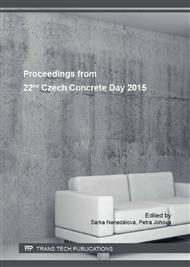p.166
p.173
p.179
p.185
p.191
p.197
p.203
p.209
p.215
Numerical Modeling of Reinforcement Corrosion on Bond Behaviour
Abstract:
Chloride-induced steel corrosion is one of the major deterioration problems for steel reinforced concrete structures. Its effects on RC structures include cracking of the concrete cover, reduction and eventually loss of bond between concrete and corroding reinforcement, and reduction of cross-sectional area of reinforcing steel. The accumulated corrosion products on the bar surface cause longitudinal cracking of the concrete cover. Loss of concrete cover leads to reduction in bond strength at the interfacial zone between the two materials. In addition, the deterioration of the ribs of the deformed bars causes a significant reduction of the interlocking forces between the ribs of the bars and the surrounding concrete keys. This deteriorates the primary mechanism of the bond strength between deformed bars and concrete, and hence, the bond strength decreases significantly. In this paper the effect of reinforcement corrosion on the bond strength between reinforcement and concrete was investigated for different corrosion levels. The effect of corrosion was simulated by the nonlinear numerical analysis with the FEM program using the 3D models.
Info:
Periodical:
Pages:
191-196
Citation:
Online since:
April 2016
Authors:
Keywords:
Price:
Сopyright:
© 2016 Trans Tech Publications Ltd. All Rights Reserved
Share:
Citation:


